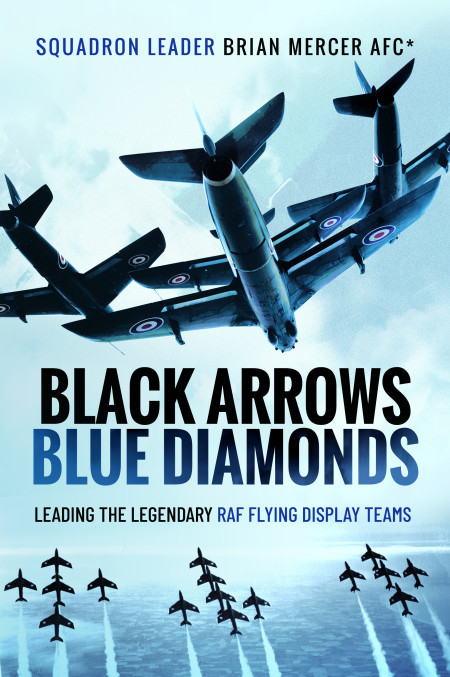Review by Stuart Forth.
The title of this book is a bit of a misnomer for, although the author was a member of No 111 Squadron’s Black Arrowsand went on to become the leader of the Blue Diamonds of No 92 Squadron, these events take up a mere two chapters of a twelve-chapter book. It is actually a very enjoyable memoir from someone who experienced a transitioning Air Force from the immediate post–Second World War piston era to a much-reduced jet operating force with a smaller presence on the world stage.
The book begins with the author’s early life and describes his childhood in wartime England before joining the Royal Air Force in 1946. Then basic flying training on the Tiger Moth and Harvard in Rhodesia is explored before going onto advanced flying training on the Mosquito back in Britain. The author then goes onto the night-fighter Operational Training Unit before being posted to No 29 Squadron at West Malling, also flying the Mosquito. Throughout this period he is critical of the use of bullying and intimidation from the ex-Second World War instructors to achieve the required standards. The author, probably correctly, considered these methods to be counterproductive.
No 29 Squadron then move from West Malling to Tangmere and transitioned to the Meteor NF.11. The author then moves onto day fighters and the Meteor 8 with No 56 Squadron before being posted to a re-forming No 111 Squadron at North Weald, also on the Meteor 8. Next comes an overseas posting to RAF Tengah to become a flight commander on No 60 Squadron with Vampires which are then ‘traded in’ for Venoms.
While at Tengah, the author starts a small four-ship display team. This is where the book falls down a bit as there is no description of why the team was formed or why the author was chosen for this duty. He just starts doing formation aerobatics! Considering the title of the book, I would have expected a little more description as to the whys and wherefores of squadron aerobatics and how the team members become qualified and chosen for such a job. The author is then posted back to 111 Squadron on Hawker Hunters and becomes a member of the world-famous Black Arrows. I’m guessing his experience with his previous squadron qualified him for this position but, once again, this reasoning is unclear in the text.
There follows a short stint as a school’s liaison officer before being asked to take command of 92 Squadron and to form a new aerobatic display team, the Blue Diamonds. As well as descriptions of the team’s display flying, the author also describes leading the squadron to victory in the Guynemer Trophy for aerial gunnery against a much-favoured team from Canada.
The next posting was a staff job, but the author saw no future for flying in the RAF, so he studied for, and gained, his Airline Transport Pilot’s Licence. He then retired from the Air Force and got a job with British Eagle flying the BAC-111 before joining Cathay Pacific in January 1968 to fly the Convair 880 and Boeing 707 out of the notorious Kai Tak airfield in Hong Kong. He eventually became the Boeing 747 fleet manager for Cathay before he was forced to retire from professional flying on health grounds.
Apart from the glaring omission of why and how the author got into formation aerobatics, this is a fun and easy read that would appeal to anyone with an interest in aviation, covering both the military and civilian aspects of the author’s career.

Leave a comment